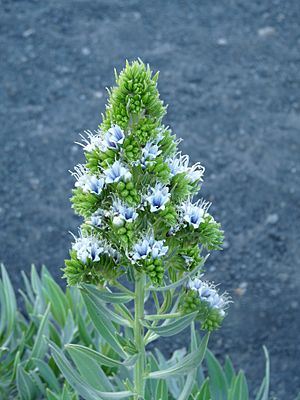Echium vulcanorum facts for kids
Quick facts for kids Echium vulcanorum |
|
|---|---|
 |
|
| Echium vulcanorum in Chã das Caldeiras. | |
| Scientific classification | |
| Kingdom: | |
| Division: | |
| Class: | |
| Order: | |
| Family: | |
| Genus: |
Echium
|
| Species: |
E. vulcanorum
|
| Binomial name | |
| Echium vulcanorum A.Chev., 1935
|
|
Echium vulcanorum is a special type of plant. It belongs to the Boraginaceae family, also known as the borage family. This plant is very unique because it is found only on Fogo island in Cape Verde.
A French botanist named Auguste Jean Baptiste Chevalier discovered and named this plant. He found it with its flowers in July 1934.
Contents
What is Echium vulcanorum called?
Locally, people call Echium vulcanorum lingua de vaca. This name means "tongue of cow". It got this name because its leaves feel rough, a bit like a cow's tongue. Other similar plants in Cape Verde, like Echium hypertropicum and Echium stenosiphon, are also called by the same name.
What does Echium vulcanorum look like?
This plant is a shrub, which means it's a woody plant smaller than a tree. It has many branches and can grow quite tall, up to 1.5 to 2 meters (about 5 to 6.5 feet). Its stems are covered with many tiny hairs.
The leaves are shaped like a lance (a type of spear). This means they are pointed at both ends. They can be up to 10 centimeters (about 4 inches) long and 1.5 centimeters (about 0.6 inches) wide.
The flowers grow in thick groups called inflorescences. These groups are almost shaped like a cone and can be up to 18 centimeters (about 7 inches) long. The flowers themselves are white with pretty blue stripes.
Where does Echium vulcanorum grow?
Echium vulcanorum is an endemic plant. This means it naturally grows only in one specific place. For this plant, that place is the island of Fogo in Cape Verde. It grows on the volcano called Pico do Fogo.
You can find it on volcanic soils, mainly in two areas. One area is Monte Losna/Pico Novo, where it grows at about 1700 meters (about 5,600 feet) high. The other main area is along the edge of the volcano's crater, known as the Bordeira region (14°55′01″N 24°21′09″W / 14.91694°N 24.35250°W). Here, it grows at even higher altitudes, between 2200 and 2400 meters (about 7,200 to 7,900 feet). A smaller group of these plants has also been seen in Chã das Caldeiras (around 1600 meters or 5,200 feet). These plants usually grow in spots that face southwest or southeast. They like soils that have recently formed from volcanic activity.
How is Echium vulcanorum protected?
Sadly, Echium vulcanorum is a threatened species. People sometimes cut it down to use as firewood (dry wood for burning). Also, goats eat the plants, which harms them. Because of these threats, this plant, along with two other Echium species in Cape Verde, needs urgent protection.
Good news! Some actions have been taken to protect the plant in the Bordeira region, which is part of the Natural Park of Fogo Island. Thanks to these efforts, there is now a good number of Echium vulcanorum plants growing there.
Images for kids
-
Echium vulcanorum in Chã das Caldeiras.
-
Echium Vulcanorum near Pico do Fogo.



